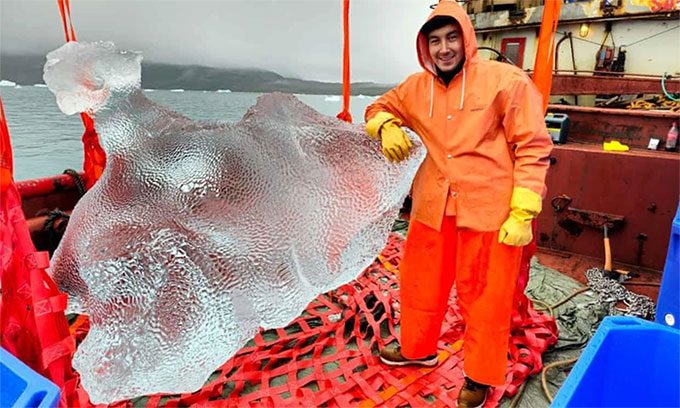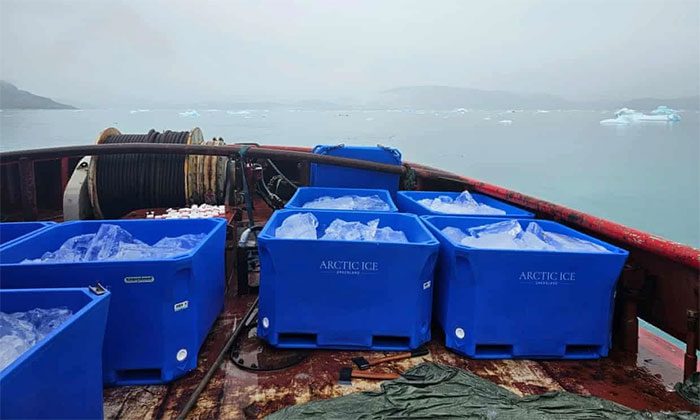Business activities involving ice from Greenland’s glaciers have emerged as a new phenomenon but are also facing significant criticism from the public.
Have you ever visited Dubai and enjoyed a refreshing daiquiri atop one of the skyscrapers in the city?
This indulgence seems to have become “outdated,” prompting a business in Greenland to devise a new way for the wealthy to enjoy their drinks. Specifically, instead of using regular ice cubes, they will use ice from glaciers to create exclusive, refreshing cocktails that are unmatched anywhere else.

The ice used for drinks must be pure ice, never touched the ground or contaminants. (Photo: Arctic Ice).
Harvesting 100,000-Year-Old Ice for Drinks
According to The Guardian, the startup company Arctic Ice harvests ice from narrow fjords in Greenland and then ships it to the UAE to sell to exclusive bars.
Using ice for drinks is a common practice in Greenland. Over the years, several people have attempted to export this product but have not succeeded.
The co-founder of Arctic Ice, Malik V. Rasmussen, stated that the ice used for drinks has been “frozen” for millennia, contains no air bubbles, and melts more slowly than regular ice. Notably, this ice is purer than the water used for ice cubes in Dubai.
On its official website, Arctic Ice claims that its products are sourced from natural glaciers in the Arctic, dating back over 100,000 years.
“These ice pieces have never come into contact with land or been affected by human-made pollutants. This makes Arctic Ice the provider of the cleanest ice on Earth,” the company states.

Black ice – as referred to by the people of Greenland – is harvested from narrow fjords and then transported to Dubai. (Photo: Arctic Ice).
To locate ice that has never touched the glacier’s bed, the company invested in a specialized boat equipped with a crane that can access the Nuup Kangerlua fjord.
The type of ice Arctic Ice seeks is purer than regular ice and is very difficult to spot in the water because it is completely clear. This is why locals refer to it as “black ice.”
Once the company finds a suitable piece of ice, they use the crane to lift it onto the boat and place it in a blue plastic container until full. After the “ice hunt,” they return to Nuuk to load the ice containers into refrigerated shipping containers.
The container filled with black ice is then transported by the Icelandic shipping company Eimskip to Denmark. Upon arrival in Denmark, the container is transferred to another ship heading to Dubai.
In the wealthy nation, Greenland’s black ice is sold by the local distributor Natural Ice before reaching luxury bars in the region.
Facing Criticism
Founded in 2022, Arctic Ice has recently shipped its first 20 tons of ice. However, the company’s business operations have faced waves of criticism on social media.
Upon learning of Arctic Ice’s sale of ice from Arctic glaciers, one critic accused the company of prioritizing profit over concerns about global warming. Rasmussen mentioned he has received even more negative messages, including death threats.
In response to the backlash, Arctic Ice defended that their ice sales are environmentally friendly and provide social value. They argue that the fjords surrounding Greenland have many icebergs that have broken off from glaciers connected to the Greenland ice sheet.
Regarding the clean ice business, Arctic Ice stated that their harvesting and exporting activities leave minimal negative impact on the environment.
The company also committed to further efforts to reduce greenhouse gas emissions and achieve carbon neutrality in the future to mitigate environmental impacts. This will involve careful planning and calculations through carbon capture and storage or technologies that remove CO2 from the air.
“Helping Greenland in its green transition is something I must do. In fact, my company has always been doing this, but perhaps we haven’t demonstrated it well enough,” said Rasmussen.
Currently, Rasmussen and the company’s main goal is to create a new revenue source for Greenland, a territory that heavily relies on Denmark for financial support. It is estimated that the annual subsidies from Denmark account for 55% of Greenland’s budget.
As a Greenlander, Rasmussen believes that to gain greater economic independence, economic growth is crucial. Therefore, he aims to develop the business to help Greenland generate additional revenue beyond fishing and tourism.


















































